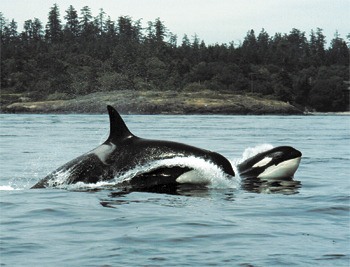By Libby Baldwin
Special to the Journal
Saving the whales doesn’t allow for time off.
With whale-watching season just around the corner and salmon recovery efforts heating up around the state, summer vacation is the furthest thing from the minds of a small group of concerned wildlife stewards.
The Salish Sea Association of Marine Naturalists was formed in Friday Harbor in 2007. The group met this past November with one question on its mind – “Where were the whales this summer?”
To answer that question, retired engineer Jane Cogan spent months on a report that combined Southern Resident orca (J, K, and L pods) sightings data with Chinook salmon data from the Albion test fishery in the Fraser River area, which she presented at the SSAMN meeting. It demonstrates a decline of Southern Resident orcas in the Salish Sea over the past decade, and shows a plausible connection with a rapid drop in Fraser River Chinook salmon.
Chinook account for 95 percent of the orcas’ diet, and the lack of the fish is one factor cited as a contributor to their dangerously low current population. Others include high amounts of toxins in the environment and noise interference from boat traffic.
During the last decade or so, there has been a noticeable difference in the time that J-Pod has been spending here during the peak whale-watching months of April through September. According to Cogan’s report, historically it has been normal to see members of J-Pod almost every day during those months.
But 2013 holds the record for lowest number of sightings since the studies on the orcas began in the mid-70s. Even the J-Pod whales were conspicuously absent this summer. According to the report, in 2004 and 2005, the J-Pod whales were sighted in local waters on more than 120 of the 153 days in the April-August period (80 percent). In 2013, the J-Pod whales were sighted in their “core summer habitat” only 27 days from April-August (18 percent).
The Albion test fishery keeps a cumulative count of the Chinook that pass through their test nets. According to its findings, although 2012 appears to be the worst year since they began keeping records in 1980, 2013 was only a fraction better. Both the Fraser Chinook and the orcas are at historically low levels that have only continued to fall.
“Without the Chinook, we will lose the Southern Residents,” said Cindy Hansen, education coordinator for the Friday Harbor Whale Museum and a founding SSAMN member.
Barbara Rosenkotter is the salmon recovery lead entity coordinator in San Juan County. She stressed that Chinook recovery is important to our ecosystem and economy as a whole, in addition to saving the orcas – just one of over 130 species that the Chinook support.
More than 90 percent of the salmon stocks in Puget Sound have perished. There are 22 distinct stocks of Chinook alone, and one generation of salmon is only five years old. The plan for stabilizing the population is not a quick fix.
Fifty year fix?
“It won’t happen overnight,” Rosenkotter said. “Our plan for recovery is a 50-year plan; it’s essential that we are in this for the long run.”
Salmon hatcheries are an important part of that plan. They provide fish for people to harvest and consume while trying to restore the wild population. Hatchery salmon are reared from eggs until they are ready to go into the saltwater, then return as adults to rear more eggs.
“Hatcheries aren’t ideal because they take out the freshwater piece of the salmon life stage,” Rosenkotter said. “Without that, the salmon lack the experience to survive on their own in the wild.”
While hatcheries aren’t a cure-all, they don’t hurt the wild salmon. Farmed fish, in contrast, never see the open ocean. They are raised in a net pen that is often rife with disease. Notably, all farmed fish in British Columbia are actually Atlantic salmon; if farmed Atlantic fish were to mingle with wild Pacific salmon stocks, it could mean disaster.
Rosenkotter noted that all the hatcheries in the world won’t make a difference to restoring the salmon population if their habitat isn’t restored first.
“Until we get some sort of stabilization in the habitat trend, restoration efforts simply aren’t keeping up with the amount of degradation,” she said.
And that’s bad news for the orcas.
Captain Hobbes Buchanan of San Juan Island Whale and Wildlife Tours is also very concerned that the loss of Chinook will lead directly to the loss of the orcas.
Some fear the worst
“In my opinion, these whales will be extinct in 5-10 years,” he said. “There’s not enough salmon and there’s too much pollution. We [in the San Juans] need to be a model for the rest of the country as far as reducing pollution.”
He suggests using more biodegradable products, especially shampoo and dish soap. He also urges erosion control practices to protect eelgrass. Forage fish, an important prey species for salmon, lay their eggs in eelgrass.
San Juan County received almost $650,000 from the state for salmon restoration in 2014. Projects include shoreline restoration, study of various factors limiting Chinook growth, and restoring access to an Orcas Island creek used by Chinook.
Smaller efforts are being undertaken as well. Filmmaker Rick Wood, in conjunction with Susan Berta and Howard Garrett of Whidbey Island-based Orca Network, is working on a film called “Fragile Waters” that he hopes will raise awareness about the dire situation of the Southern Resident orcas and what can be done to stabilize it.
It is good news that so many are so concerned about the state of salmon and orca recovery; only time will tell if all the positive efforts will pay off and bring our ecosystem back to its former glory.
— Editor’s note: San Juan Island freelance writer Libby Baldwin’s articles are published periodically by The Journal


